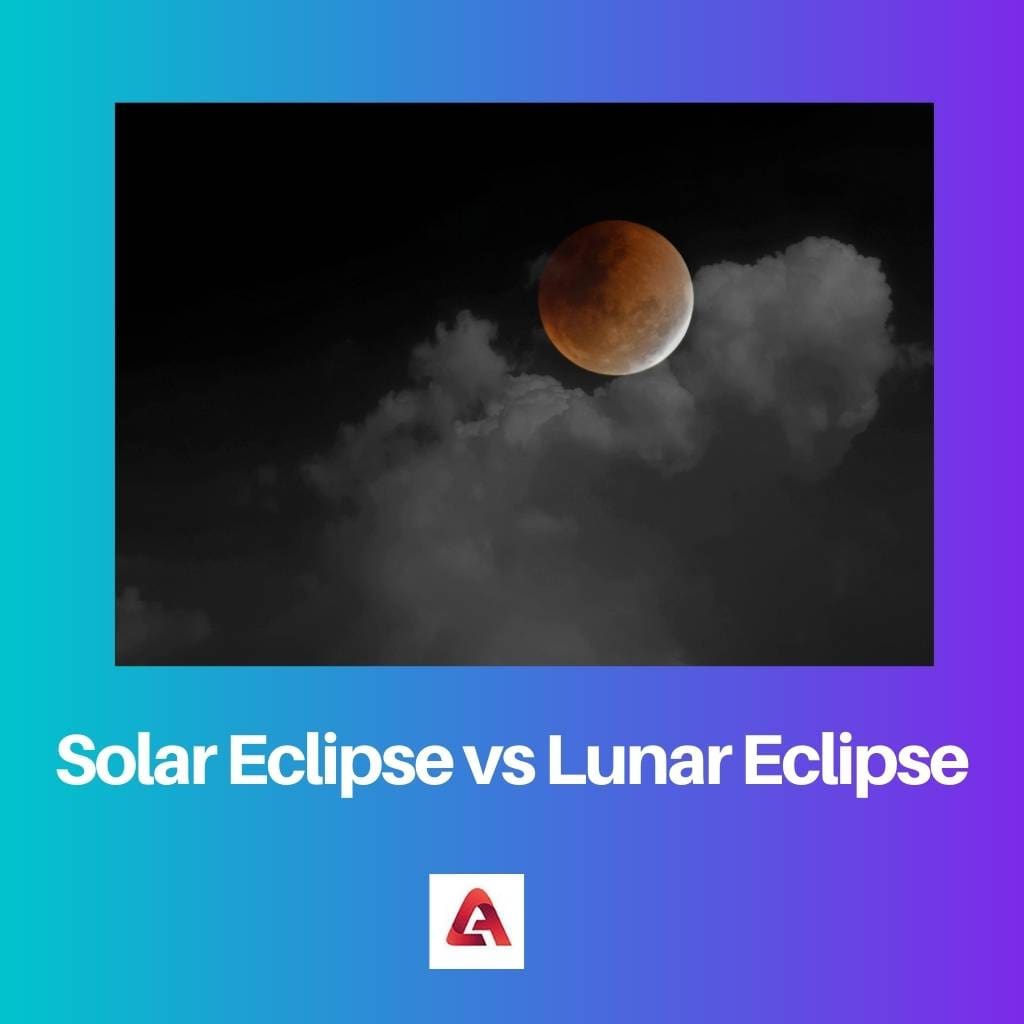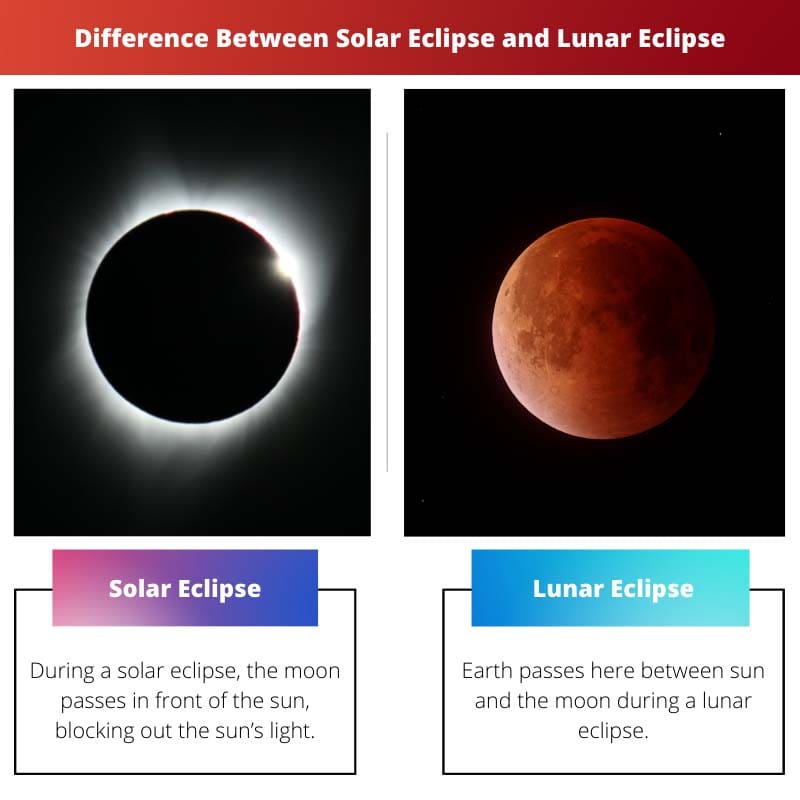As the name implies, an eclipse occurs when light from such a celestial body is blocked by radiation from some other celestial object passing through it and vice versa. It occurs when three heavenly objects, the sun, moon, and earth, are in close proximity to each other.
If there is a solar eclipse, the Sun, Moon, and Earth will always be in sync with each other during the event. While in some circumstances, it does not interfere with sunlight, in other cases, it does.
Key Takeaways
- A solar eclipse occurs when the moon blocks sunlight from reaching the Earth, while a lunar eclipse occurs when the Earth’s shadow falls on the moon.
- Solar eclipses can only be observed during the daytime and are visible from specific locations, while lunar eclipses can be seen at night from any place on Earth with a clear view of the moon.
- Solar eclipses require safety precautions, while lunar eclipses can be observed safely without protection.
Solar Eclipse vs Lunar Eclipse
The difference Between Solar Eclipse and Lunar Eclipse is that, unlike Lunar Eclipses, Solar Eclipses occur anytime the earth is considered to be travelling through a lunar eclipse. Whenever the moon totally conceals the sun and its retinue, it is a total solar eclipse, which is the most common type.

All of the planets, like the sun, moon, and Earth, are in synchronicity when a solar eclipse occurs. Among Earth and the Sun, the moon appears and either continuously or intermittently blocks off the sun’s rays of light.
This type of solar eclipse is referred to as a full solar eclipse, whenever the moon completely obscures all or part of the sun.
Whenever the Moon goes further into Earth’s shadow, it causes a lunar eclipse to emerge. Also, on the day of a full moon, such alignment occurs only if the Sun, Earth, as well, as Moon are perfectly or extremely closely in harmony (in syzygy).
How long a lunar eclipse lasts and what form it depends on how close the Moon is to each node of its orbit.
Comparison Table
| Parameters of Comparison | Solar Eclipse | Lunar Eclipse |
|---|---|---|
| Anatomy | During a solar eclipse, the moon passes in front of the sun, blocking out the sun’s light. | Earth passes here between sun and the moon during a lunar eclipse, shutting out those celestial bodies and causing the eclipse. |
| Occurrence | Solar Eclipse occurs once every 1.5 years. | On the other hand, Lunar Eclipse occurs more frequently, i.e., twice a year. |
| Lasts for | A Solar eclipse stays for almost 5 minutes to 7 minutes and is witnesses in few places. | Whereas a Lunar Eclipse lasts almost for an hour and is witnessed in many places. |
| When seen directly | A high risk of blindness exists if the substance is viewed with the naked eye, as it destroys the retina. | Lunar eclipses can be viewed with no protective eyewear because they do not inflict any injuries to the eyes. |
| Happens in Phase | At the time of a new moon, a total solar eclipse unfolds. | At the time of a full moon, a Lunar Eclipse unfolds. |
What is Solar Eclipse?
Eclipse of the sun occurs when the moon blocks the sun’s light. Eclipses occur when a full or partial eclipse occurs once the moon crosses the line of sight of the sun while orbiting around Earth and crosses in front of the sun, obstructing its view.
A solar eclipse happens as a consequence of blocking daylight from reaching the ground, culminating in some portions of the planet being shadowed by the moon. In general, this only occurs on the new moon, only whenever the moon is in a favourable position to be seen from the Earth.
Sun, Moon, and Earth have always been in synchrony if a solar eclipse occurs because they are all in sync. Earth, as well as the sun’s source of light, is obscured by the moon, which appears somewhere between the two bodies.
Once the moon permanently disables the sun, it is called a total solar eclipse, while a partial solar eclipse occurs when only a piece of the sun is blocked out. ‘Surya Grahan’ is the term coined for a solar eclipse in India.

What is Lunar Eclipse?
In a basic manner, Whenever the Moon goes further into Earth’s shadow, it causes a lunar eclipse to emerge. Also, on the day of a full moon, such alignment occurs only if the Sun, Earth, as well, as Moon are perfectly or extremely closely in harmony (in syzygy).
How long a lunar eclipse lasts and what form it depends on how close the Moon is to each node of its orbit.
If both the Sun as well as the eclipsed Moon are visible at the very same moment, it is called a selenelion/selenehelion. Only shortly prior to or soon after sundown or sunrise can you view this event, as both bodies will be visible at virtually opposing locations in the sky.
Observers perceive a selenelion throughout each total lunar eclipse; it is not really a planetary event taking place independently of the eclipse.
During an eclipse, the Moon’s distance from Earth might impact the eclipse’s duration. The Moon’s rotational pace is the least when it has been approaching apogee, the most distant point from Earth in its rotation.
When the Moon’s orbital separation varies, the width of Earth’s umbra doesn’t really alter noticeably. As a result, the full eclipse will last longer if a completely eclipsed Moon occurs near apogee.

Main Differences Between Solar Eclipse and Lunar Eclipse
- During a Solar Eclipse, the moon crosses in front of the Sun, blocking the passage of light from the source. Whereas, in the case of the Lunar Eclipse, the Earth passes between the Moon and the Sun, shutting out those celestial bodies and causing the Eclipse.
- Solar Eclipse occurs once after every 1.5 years. On the other hand, Lunar Eclipse occurs more frequently, i.e., twice a year.
- A Solar eclipse stays for almost 5 minutes to 7 minutes and is witnessed in few places. Whereas a Lunar Eclipse lasts almost for an hour and is witnessed in many places.
- A high risk of blindness exists if the substance is viewed with the naked eye, as it destroys the retina. Lunar eclipses can be viewed with no protective eyewear because they do not inflict any injuries to the eyes.
- A solar eclipse occurs whenever there is a new phase of the moon. In addition, a lunar eclipse actually takes place during the full moon’s period of time.

- https://www.researchgate.net/profile/Fethiye-Karsli-2/publication/303247590_Effects_of_the_context-based_approach_on_students’_conceptual_understanding_The_umbra_the_solar_eclipse_and_the_lunar_eclipse/links/5739e87a08aea45ee83f7478/Effects-of-the-context-based-approach-on-students-conceptual-understanding-The-umbra-the-solar-eclipse-and-the-lunar-eclipse.pdf
- https://www.cambridge.org/il/files/1813/6681/7658/3577_Color_Ch_7_figs_2.pdf

The article was excellent at explaining the scientific details behind eclipses, but in a way that is accessible to all readers.
I completely agree. It’s refreshing to read scientific content that is both informative and understandable for everyone.
The comprehensive comparison between solar and lunar eclipses was very educational. The clarity of information in this article is commendable.
Yes, the level of detail provided in the comparison was truly impressive. I learned a lot from this.
I appreciate the detailed explanation of how solar eclipses occur, very clear and easy to understand.
Yes, the article did a great job at breaking down the process step by step.
I found the detailed explanation of how lunar eclipses occur to be incredibly enlightening. Well done!
I was also impressed by the clarity of the explanation. Very well-written article.
I now have a much clearer understanding of solar and lunar eclipses after reading this article. The in-depth explanations were wonderful.
I wholeheartedly agree. The way the details were presented made for a very enriching reading experience.
I really enjoyed reading about the differences between solar eclipses and lunar eclipses, very informative
Yes, I found it quite interesting as well. I didn’t know that lunar eclipses occurred more frequently than solar ones.
The information about the potential risks of viewing a solar eclipse was particularly valuable. Safety should always be a priority when observing any celestial event.
Absolutely, it’s great to see a focus on safety in an article like this.
I didn’t realize that lunar eclipses are visible from anywhere on Earth with a clear view of the moon. That’s quite fascinating.
Yes, it’s amazing how lunar eclipses can be seen by so many people around the world. I learned a lot from this article.
The comparison table was very helpful in understanding the key differences between solar and lunar eclipses.
Agreed, the table was a great addition. I especially appreciated the information about how long each type of eclipse lasts.
Learning about the phases at which each type of eclipse occurs was fascinating. I now have a much better understanding of these celestial events.
I agree, this article really clarified many aspects about solar and lunar eclipses.
I also found the explanation of the eclipse phases very helpful. This is quite an enlightening read.